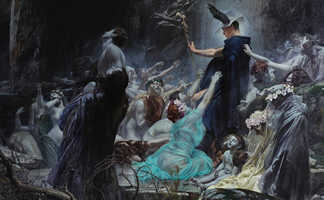When the “Big Three” Olympians (Zeus, Poseidon, and Hades) had lots drawn for the assignment of sovereignty over the three major divisions of the world, Zeus was given the earth, Poseidon the sea. The final lot, that of authority over the underworld fell to Hades.
Although he was not Death personified, Hades had control over Thanatos, who was Death personified. Thanatos was the son of Nyx, goddess of the night, and the brother of Hypnos, the god of sleep. Indeed, sleep is known as “the little death.” But I digress.
So the chain of command involving the death of every human being in the Greek world starts with Hades, who commands Thanatos, who carries out his grim task of ending an earthly life. The dead are then ferried across the river Styx by Charon, the familiar hooded, faceless being who has evolved to represent death in Western culture. Charon is familiarly known as the Grim Reaper. But in fact, it is Thanatos who reaps.
Several of these names are still in abundant use today in modern Greek. Sleep is still called “hypnos” (we get the word “hypnotized” from this), death is still known as “thanatos”, and a form of Nyx- “nixta”- is still known as “night.”
Unique among the Olympians, Hades is both the name of a god, and the name of a place- the underworld. To the Greeks, Hades as a toponym was simply the abode of the dead.
Interestingly, Hades was also known as Pluto in the Greek world. The Romans adopted Pluto for their own. The reason Hades was also known as Pluto to the Greek is that he had sovereignty over the minerals of the earth and was thus able to make men rich. “Plouti” is still the modern Greek word for “riches.”
Hades inspired a certain amount of dread even in his fellow Olympians. For that reason he was generally unwelcome in Olympus, and for the most part kept to his palace in the underworld. He certainly inspired dread in mortals; Greeks avoided even pronouncing his name, lest they hasten their own death. Hades was a god without pity; it was useless to sacrifice to him, because death was inevitable to all. He is never very developed as a personality. He’s just there, stern, aloof, and waiting for his appointment with every single human being.
Life After Life
The Greek view of life after death was pretty harsh- Hades was a place of shadows, of shades of grey, inhabited by the departed who had nothing useful to do. In Book II of the Odyssey, Odysseus has an encounter with the departed Achilles. Achilles tells him he would rather be a living slave than a ruler in the underworld. This view of the afterlife had evolved by the 4th century, BC, in which the souls of those who were good in this life were rewarded in the afterlife, but only insofar as their memory was honored in the land of the living.
It’s an open question as to whether the Greeks were influenced by established Jewish thought about the afterlife as delineated in the Jewish Bible- the Old Testament- which had been pretty much canonized by the 4th century, BC. The Greeks were a seafaring people and almost certainly had contact with the Jews, although there is no solid written evidence of Jews living in Greece until about 300 BC.
In the dialogue of the Phaedo, Plato has Socrates (428-348 BC) theorize that the soul devoted to God (Socrates was essentially a monotheist) and good behavior in life would be rewarded in the afterlife, whereas the one who indulged in fleshly appetites and took advantage of others had miserable afterlives, full of regret for lost opportunities to behave well.
The region of the dead was divided into various levels, according to Homer. Those who had lived decent and moral lives, and continued to be remembered and honored by the living were assigned a pleasant place known as the Asphodel Meadows, asphodel being a fragrant white flower. The Elysian Fields were where the brave who died in battle, mortals who had been related to the gods, and the righteous and heroic who were chosen by the gods to abide after their death.
“…the Elysian plain...where life is easiest for men. No snow is there, nor heavy storm, nor ever rain, but ever does Ocean send up blasts of the shrill-blowing West Wind that they may give cooling to men.”
— Homer, Odyssey (4.560–565)[12]
Finally, there is Tartarus. Tartarus was an abyss and the abode of the wicked dead, a place of suffering and torment, originally designed for the Titans after the Olympians rebelled successfully against them. Like Hades, Tartarus was also the name of a deity, and one of the earliest, one of the three primordial deities, along with Chaos and Gaia. The poet Hesiod (circa 700 BC) said that an anvil falling from heaven would take nine days to reach the earth, and then another nine days to reach Tartarus. And Zeus states, in the Iliad, that “Tartarus is as far beneath Hades as heaven is above the earth.” Tartarus eventually lost its distinctive character and became synonymous with Hades. The Greek translation of the Old Testament (circa 280-250 BC) use the word “Hades” for the Hebrew “Sheol,” abode of the dead.
Unique Attributes
There are three unique markers which identify Hades. First, he had a chariot drawn by four black horses.
Second, he had a fearsome companion, the three-headed dog, Cerberus, also known as the Hound of Hades. Cerberus guarded the exit to Hades, ensuring the dead would stay there for all time. He also had a serpent tail, and snakes protruding from his body. Third, he had a cap or helmet that made the wearer invisible. The cap was used by other deities as well, such as Athena, who wore it during the Trojan war in order to fool Ares, and Hermes, who wore it to defeat the Giant, Hippolytus.
His Wife
Hades had a queen consort, Persephone. Theirs was a loving, faithful relationship, which is very rare for Greek gods. The story of Hades and Persephone is the most famous tale concerning Hades, and one of the greatest and most clever myths, since it combines a compelling story with a mythical explanation for the changing seasons. The myth of Persephone, Hades and Demeter became the central story around which revolved the greatest mystery religion in the ancient Greek world, that of the Elysian Mysteries.
The myth is most fully told in the Homeric Hymn to Demeter, one of a group of thirty-three hymns attributed to Homer with the Greek pantheon as their subject matter.
Persephone, daughter of Demeter, was out picking flowers one day, when the earth opened up, and Hades, who had spied her from afar and desired her, rode up out of the earth on his chariot drawn by his black steeds. He snatched the poor girl, returned to the underworld with her, and her distraught mother was unable to find her. Demeter immediately went in to mourning, and the earth’s vegetation, left unattended, withered and died.
She eventually learned the truth from Helios, the Sun, who witnessed the abduction. Zeus, hearing the cries of the hungry people whose crops refused to grow, commanded Hades to return Persephone. He did so, but only after tricking her into eating six pomegranate seeds. Because she ate of the food of the underworld, she was therefore forced to return to Hades’ side for six months of the year. The other six months she was allowed to live with her mother. These months saw the earth flower again, and crops being sown and harvested- summer. The other six months, while she was with Hades, the plant life on earth would wither and die- winter.
Since Persephone was returned near Eleusis, a temple was built there and the Elysian Mysteries were instituted. The ceremonies of the Mysteries were a strictly kept secret, under pain of death. The secrets of the Elysian Mysteries were so successfully kept that to this day no one knows exactly what took place during them.
Persephone, in the meantime, took her place as Queen of the Underworld, where she ruled by the side of Hades six months a year. Maybe that’s why their marriage was so successful- they were forced to take a six month break from each other every year.
Hades had very few temples dedicated to him- as mentioned, it didn’t much help to burn sacrifices to him, since death is inevitable to all. Hades has become a sort of symbol of the unseen and the unknowable. In fact, etymologists believe his name origin means “the unseen.” Unlike the rest of nature, we cannot see the dead after they’ve left the earth, and we cannot see Hades’ kingdom.




















